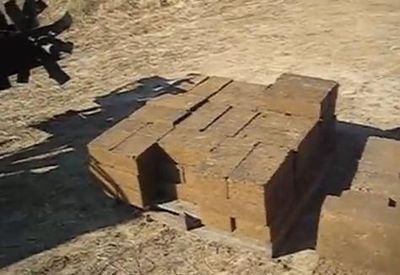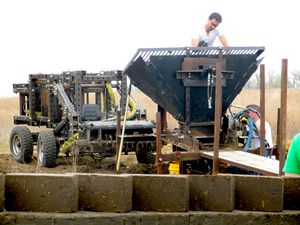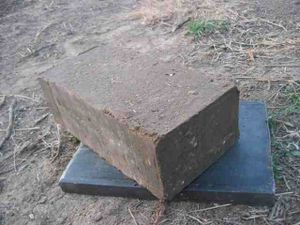Compressed Earth Blocks
Overview

Compressed Earth Blocks are the main construction material used in the GVCS Compressed Earth Block Press (formerly called The Liberator).
CEB Construction is a powerful technique for empowering communities to produce on-demand housing.
The bricks do not require curing - so a machine may churn out bricks on-site that can be continuously added to the building. CEB lends itself to 100% onsite building material sourcing. The thermal insulation, sound insulation, and strength of the bricks are excellent.
CEBs can also be used in fences, cisterns, road paving, ovens, dams, thermal storage cisterns, silos, barns, dairy plant, bakery building, greenhouses, raised garden beds, etc.
Materials used in compressed earth blocks
CEBs are made from soil that is 15-40% non-expansive clay, 25-40% silt powder, and 40-70% sharp sand to small gravel content. The more modern machines do not require aggregate (rock) to make a strong soil block for most applications. Soil moisture content ranges from 4-12% by weight. Clay with a plasticity index (PI) of up to 25 or 30 would be acceptable for most applications. The PI of the mixed soil (clay, silt and sand/gravel combined) should not exceed 12 to 15; that is the difference between the Upper and Lower Atterberg limits, as determined by laboratory testing.[1]
Selection and preparation of the soil are important to getting the best results from a CEB press. See the CEB Blocks page.
CEB Shapes and Sizes
(TODO: Add pictures of CEBs built with The Liberator; show different shapes and sizes it can make)
To Interlock on Not to Interlock
Alternative Materials
- Krafterra: A researcher from UnB (University of Brasília, Brazil) suggests the use of kraft paper from cement bags mixed with earth to obtain better CEBs, dubbed krafterra.
- Wool
- Geopolymers: Although cements are the most common application of geopolymerization, a range of refractory and structural products have been produced. The products of geopolymerization are called poly-silicates.
- Galvinized wire? Galvinized wire reinforcing would be light and could probably provide extra resistance to earthquakes. The prices are similar to rebar per pound, but there is perhaps 5 times the support per pound of material. Does not need double thickness, which cuts down on labor.
Aesthetics
Stick frame construction is the main building method in North America. It is a weak but fast building method, which makes money for developers but returns little value to the homeowner, if one considers lifecycle cost of buildings. (note the lifecycle use of materials in Greenforms at CMPBS) Procuring lumber drains money out of local economies. This is not to mention clear-cutting and vast lumber monocultures that supply the lumber. We are interested in raising the standard of building, away from stick frame. We believe that with all these considerations, the CEB is the only building technique that even remotely has a chance of substituting for stick frame construction, and that with our machine, priced $3-5k and designed for fabrication replication, will fill in a great need. CEB construction has the potential for mainstreamability in home construction.
Soil Composition
(Unverified Method, Citation) "A simple soil composition test can be done with a clear jar and some water. Fill the jar half way with soil, then add water to the top. Add a few spoon fulls of salt to help with the separation. Shake the jar vigorously, and then set it down and allow the contents to settle for an hour or two. Once the contents have settled, you will see specific layers form. The bottom layer will be your aggregate, then your clay/silt layer, and finally the organic material will be on top. You want about 15-40% clay/silt to 60-85% sand. Little to no organic matter is best." [2]
Advantages of CEBs
Thermal properties
CEBs are excellent thermal insulators. In very cold climates, a superinsulated building can be made by putting a layer of insulation between two layers of CEBs - see Superinsulated CEB Construction
Furthermore, they lose and gain heat less quickly than surrounding air. As a result of this, they store warmth in cold weather, and coolness in hot weather.
Comparison to other natural building methods
If you want to build a home from natural materials, you have a choice of -
- Wood: stick-frame, timber frame, post and beam
- Structural masonry: brick, concrete block, rock, CEB (note that CEB falls into the class of structural masonry)
- Earth-mix: adobe, rammed earth, stabilized earth blocks, cob, earthbag
- Other natural building methods: strawbale, cordwood, papercrete, earthships and variations of all types.
Earthbag and cordwood construction, though cheap, take too much time. It takes about $400 and 400 man-hours to build the walls and roof of a 200 square foot (18.6m2) room. Earthbag construction requires filling, stacking and tamping bags of earth. As the walls get higher, the bags must be lifted accordingly. Barbed wire is strung between layers of bags. The process is not easily mechanized. And the walls require stuccoing afterwards. Cordwood was also difficult. Wood has to be cut, stacked, restacked and stacked again. We were surprised at how much wood was required for a small addition. Furthermore, both cordwood and earthbags have the distinct disadvantage of being irregular. By contrast, CEB construction takes much less time. This is because the blocks made are uniform, whereas other natural building methods use irregular materials.
Wayne Nelson of Habitat for Humanity in his piece entitled "Compressed Earth Blocks" says, "Uniformly sized building components can result in less waste, faster construction and the possibility of using other pre-made components or modular manufactured building elements." High uniformity gives CEB a competitive advantage over other natural building methods, allowing the CEB to influence local economies as a building medium.
Local production
Compressed earth blocks exemplify the quality "locally-made". The required clay-sand subsoil is locally available nearly everywhere. Even the mortar is made from this mix with additional water. (See: Wikipedia) Humus-rich top-soil can be preserved for agriculture and the resulting hole may become a basement, root-cellar, pond or smoothed out to blend with the landscape. If onsite soil is insufficient (ie. not enough, or unbalanced) near-by off-site soil or amendments might be an appropriate option. Miles traveled: near Zero.
Compare this to the stick-frame house. According to "Gate-to-Gate Life-Cycle Inventory of Softwood Lumber Production" by Michael R. Milota, Cynthia D. West, and Ian D. Hartley, lumber travels 65 miles on average, just to get to the mill. Numerous unnatural materials are often used (ie vinyl siding and insulation) that have their own set of negative ecological consequences.
Other natural building methods have variably high scores on local, ecological use of materials, provided the materials are locally abundant.
A CEB press can also enhance the local economy through a brickworks facility. Bricks can be made competitively at a local scale. In "Compressed Earth Block Volume 1: Manual of Production" by CRA Terre, Vincent Rigassi (see D.10), CEB is pronounced as "one of those rare 'modern materials' which has sufficient production flexibility to enable it to be integrated into both formal and informal sectors of activity, from 'cottage' industry to full-scale industrial plants" (pg 5).
The third opportunity for local production is to manufacture CEB presses. Our open-source CEB machine The Liberator is designed to be built with simple tools and off-the-shelf parts. There is an opportunity for huge profits here as other CEB presses are expensive ($25k for one of 3-5 brick/minute performance). The Liberator's design has minimum welds, using only bolts to secure the frame together. Since no specialized tools or advanced skills are needed, a local machine shop or adventurous entrepreneur can easily manufacture it, contributing to the local economy.
Durability
Strength
Strength of CEBs depends on the machine (especially automated versus manual) and the quality of the soil (poorly mixed soil can lead to a weaker brick). According to Wikipedia, "CEB can have a compressive strength as high as 2,000 pounds per square inch. Blocks with compressive strengths of 1,200 to 1,400 p.s.i. are common." In 201, we determined the CEBs produced from The Liberator to be 795 psi and over 1,200 psi for CEBs stabilized with reject lime and 10% Portland cement by volume.[3]
The compressive strength of CEB sounds impressive, but according to Fred Webster, Ph.D. seismic Engineer in his paper "Some Thoughts on'Adobe Codes', it is neither the only nor the most important variable in determining the ability of CEB's to withstand loads. "In actuality, high compressive strength is and should not be the greatest concern related to pressed block quality. If the block has a compressive strength of 1000 psi rather than 300 psi, it is quite superfluous to the performance of the building subjected to ordinary service loads or even earthquake loads. It is not requisite that earthen blocks be up to the standard of concrete in order to perform well during severe earthquake shaking." Webster suggests that soil quality may be more important than compressive strength in determining the bricks overall durability. "Standards for appropriate soil selection need to be aggressively and rationally developed and tested by the pressed block industry. Currently, the best standards and research are being performed by BASIN, a combined appropriate technology effort made up of Germany, England, Switzerland, and France" (Webster).
Water Resistance
Although high quality blocks are water-resistant, they are not fully waterproof and commercial builders, such as Midwest Earth Builders use a stucco to protect the exterior walls. Other design features, such as a large overhang, can also provide some protection against weathering.
CEB buildings may need to be re-finished with stucco coating, just like a house would occasionally need new paint. If a conventional roof is used, maintenance repairs would be identical to a traditional house. More research is needed on maintenance costs of a CEB building.
Additives to Increase Water Resistance
Chemicals called pozzolans have been used for centuries to cause a hydraulic cementing reaction with hydrated lime (CaOH, calcium hydroxide) in damp or wet conditions.
The Romans used volcanic ash with lime and sand to yield a concrete still unrivaled by modern technology.
More common pozzolans may include brick dust (fired below 900*C) and fly ash from power stations.
In theory, the addition of pozzolans such as brick dust to a dry mix of sand, clay, and hydrated lime could yield CEBs that could be used in wet or damp conditions such as retaining walls.
I propose that these CEBs would require a curing period, following pressing, under plastic to encourage hydraulic cement reaction of lime and pozzolan.
Fire and Mold-proof
Economics: The press, initial building cost, maintenance
We have found that earthbag and cordwood costs about $30 per square foot ($322 per square meter) where labour is valued at $10/ hour. CEB construction should be about 5 times cheaper than that; data to follow.
The main cost is the machine for making the CEBs. Commercial versions that make 3-5 blocks a minute cost $25k. This is one reason why we have built The Liberator, an open-source CEB machine that costs $3-5k and can make 9 blocks a minute.
A tractor with loader and rototiller are required to prepare the soil. These are additional costs. Other equipment and their related costs are detailed in the pdf CEB manual D.10 found on the BASIN website.
Building Costs
MEB claims, "[c]ost on a per block basis average approximately $1.10 per block. A 1000 square foot home will need approximately 5,500 blocks. So, $6,050 would be the block costs. Once again, we have worked with customers who have provided their own labor and tractor for loading, and have brought this cost down to $.50 to $.60/block."
CEB press maker AECT claims, "the cost of the structural compressed earth block construction using the AECT structural compressed earth block machines to produce the structural masonry blocks is between 25-40% less expensive than the next closest construction approach for quality, long lasting and energy efficient structures. Some other cheaper construction techniques are inexpensive, but the resulting housing or commercial buildings are cheap, structurally deficient, noisy, and wasteful in energy use and not appealing to homeowners or commercial tenants."
But when compared strictly on economic terms to a conventional home, natural building methods save surprisingly little. Most natural building methods use convential roofs and foundations. Only the walls are constructed from alternative materials.
From their experience, Midwest Earth Builders (MEB) claim "Because CEBs are used entirely as a wall system, the remaining costs, which can represent 80-90% of the total cost of the home, will be the same as conventional building. For example, the cost of the roof, windows, cabinets, etc. are the same for a framed and CEB home.
Building the wall of a home typically represents 10-20% of the total cost of a home. A CEB wall will average 15% more then a conventionally built wall. In other words if the wall of a conventional home cost $15,000 for a $100,000 home, it will cost $2,250 more for a CEB wall."
A similar summary of straw bale housing is given from Green Home Building. "Erecting bale walls can go amazingly quickly, and does not take a lot of skill, but then the rest of the creation of the building is similar to any other wood framed house. In fact strawbale houses typically only save about 15% of the wood used in a conventionally framed house. The cost of finishing a strawbale house can often exceed that of standard construction, because of the specialized work that goes into plastering both sides of the walls. The result is often worth it though, because of the superior insulation and wall depth that is achieved."
A commerical, pre-built 200 sq ft "deluxe shed" costs $4,400. Missouri minimum wage is $6.50, but if we gave the workers a nice $10/hour, the price is equivalent. (Another company quoted their shed at $4,009 and I found a two-year old aluminum one on craigslist for $1500, which was originally bought at $2500.)
Other points to consider:
- Skill level. Stuccoing straw bale buildings may be better left to a professional. CEB requires little skill and is therefore, a good choice for the owner-builder. Normal masonary work requires skilled professionals to apply a thick (1/4-1/2") layer of mortar between layers of bricks, but "because earth blocks do not require thick mortar joints, walls can be built quickly by workers unskilled in masonry" (MEB). MEB explains, "One does not have to be an experienced mason to build with CEBs. Homeowners, contractors, and builders can quickly be taught how to stack a wall and begin construction immediately. Because only a thin mortar/slurry joint is used between blocks, walls go up quickly and there is no need to wait for the mortar to set up after a few rows like with typical brick masonry."
- Can other parts of the building be made more economically? CEB can be made into roofing shingles with a roof-tile mold [Link?] . Conventional roofs are easily held by CEB: "If the block has a compressive strength of 1000 psi rather than 300 psi, it is quite superfluous to the performance of the building subjected to ordinary service loads or even earthquake loads" (Webster). Thus, it seems safe to assume that a CEB wall, appropriately constructed, could hold up the weight of a living roof. Although again, with current technologies, it is more expensive up-front, with long-term savings in maintenance and heating.
- Because CEB is an on-site material and because all parts of the process can be done by hand or machine, it lends itself to great variability of final product prices. Habitat for Humanity uses CEB in some of their projects. And BASIN is comprised of organizations which do development work. So, obviously, CEB homes do NOT need to cost as much as conventionally-built ones.
Disadvantages of CEBs
The CEB does fall short of perfection in a couple respects. The press and other needed equipment (ie. rototiller and tractor) are not made from locally harvested materials. However, almost all building methods require use of some heavy machinery, and to its advantage, the press is designed to be locally manufactured. Also, The Liberator is not designed to make roofing shingles (although these can be made from compressed earth). So, the ecological qualities of the roof cannot be addressed. Soil composition may not be appropriate on some sites as well which would mean appropriate soil would need top be transported from elswhere (source). A potential untested method to perform a basic soil test is described here- http://velacreations.com/shelter/building-materials/dirt/49.html
More Information
- CEB Press - Full information on our high-performance, low-cost, open-source CEB machine: The Liberator.
- The Liberator Full Product Release
- Earthquake safety
- CEB FAQ from Instituto Tierra y Cal
- 100-page CEB handbook from a Unesco project in Sudan
- Overview of CEBs, by Jim Hallock
- What should we have in mind when acquiring a CEB press? - CEB legal issues and norms in Brazil
- appropedia: Compressed earth brick press
- Auram earth construction equipment and blocks from Auroville Earth Institute (available in many shapes).
- Rammed Earth Construction from Autonopedia
- Rammed/Stabilized Earth from Green Building Encyclopedia
- Advanced Earthen Construction Technologies
- Powell and Sons CEB machines
- Gernot Minke - one of the world's leaders in earth construction - see here for thorough overview, including detailed soil testing procedures.
- Galvanized wire reinforced, earthquake resistant earth construction techniques publication - [1]
- Ronald Rael is an Architect, Author and Assistant Professor of Architecture at The University of California, Berkeley. He is the founder of EarthArchitecture.org, a clearinghouse of information on the subject.
- Compressed Earth Block Guide - [2]
- GTZ manuals on CEB technology: Volume I, Manual of Production and Volume II, Manual of Design and Construction
- Other information - [3] , [4]
- propagelle project
- CEB for wet/hurricane climates (Louisiana USA)

